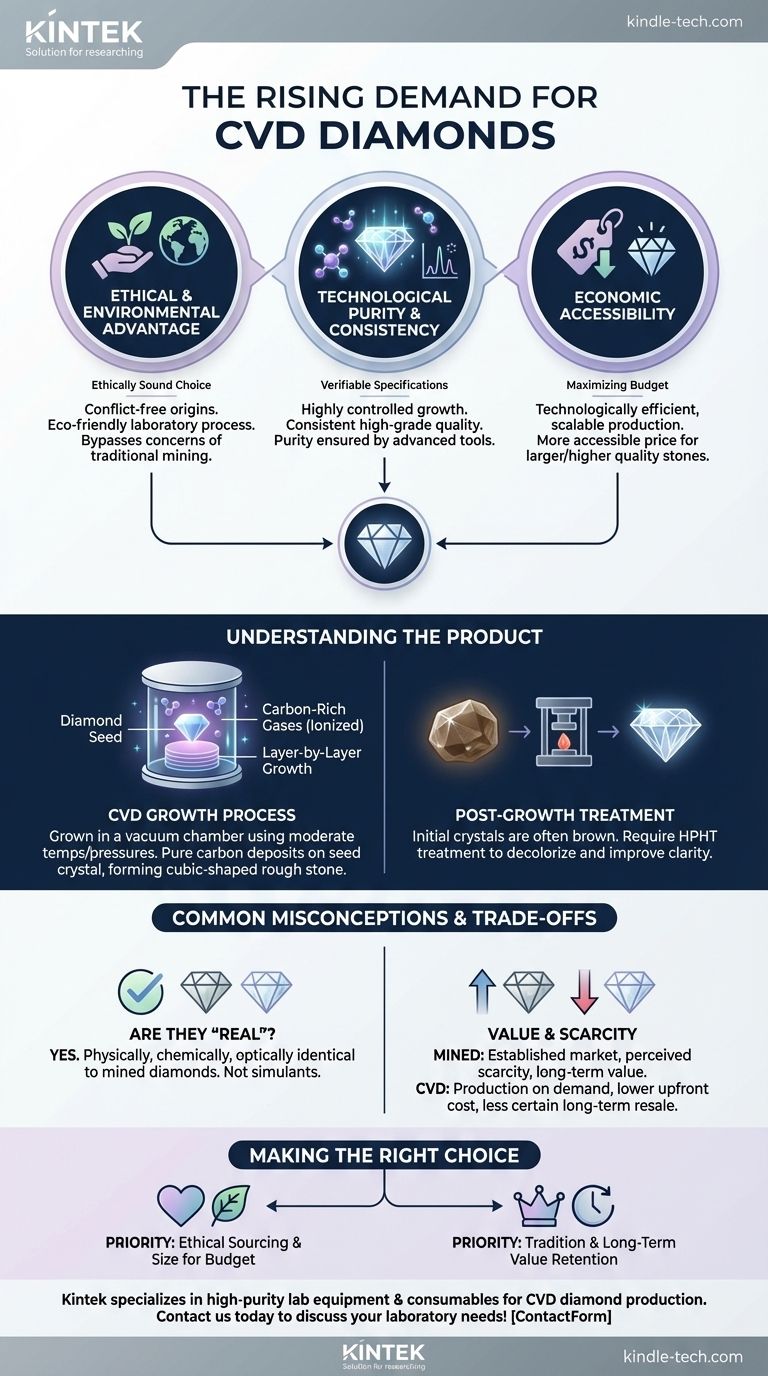At its core, the demand for Chemical Vapor Deposition (CVD) diamonds is driven by a powerful combination of ethical considerations, technological advancements, and economic accessibility. While specific market figures fluctuate, the underlying trend is a significant and growing consumer appetite for diamonds that are both physically real and produced in a controlled, responsible manner.
The rise in demand for CVD diamonds is not simply about finding a cheaper alternative. It reflects a fundamental shift in consumer values, where the origin, environmental impact, and technological purity of a product are becoming as important as its physical beauty and price.

The Core Drivers of CVD Diamond Demand
The market's increasing interest in CVD diamonds isn't based on a single factor but on a convergence of powerful modern trends. Understanding these drivers is key to understanding the product's position in the broader jewelry and industrial landscape.
The Ethical and Environmental Advantage
A primary driver of demand is the guarantee of conflict-free origins. Consumers are increasingly aware of the ethical and environmental toll of traditional diamond mining.
CVD diamonds are grown in a highly controlled laboratory environment. This process completely bypasses the concerns over "blood diamonds" and the ecological disruption associated with large-scale mining operations, making them an ethically sound choice.
Technological Purity and Consistency
The CVD process allows for an exceptional degree of control over the diamond's creation. The final quality is directly tied to the purity of the source materials, such as methane and hydrogen.
By using tools like process gas chromatographs to ensure feedstock purity, producers can create consistently high-grade diamonds. This reliability is a significant factor for buyers who prioritize quality and verifiable specifications.
Economic Accessibility
Technological efficiency directly impacts the final cost. The ability to manage the speed of a diamond's growth based on its target size and the technology used makes the CVD process highly scalable.
This efficiency translates into a more accessible price point for the consumer compared to a mined diamond of equivalent size and quality. This allows buyers to purchase a larger or higher-quality stone within their budget, a powerful incentive that fuels demand.
Understanding the Product Behind the Demand
To truly grasp the market appeal, it's important to understand the fundamental characteristics of the CVD diamond itself. These attributes are a direct result of its unique creation process.
The CVD Growth Process
CVD diamonds are grown in a vacuum chamber using moderate temperatures and pressures. A diamond seed is placed inside, and a mixture of carbon-rich gases is introduced.
These gases are ionized, breaking their molecular bonds and allowing pure carbon to deposit onto the seed crystal. The diamond grows layer by layer, typically in a single growth direction, resulting in a distinctive cubic-shaped rough stone.
The Need for Post-Growth Treatment
The initial crystals produced via the CVD method are often brown in color. They may also have rough edges of non-diamond carbon, like graphite, that must be removed.
These stones almost always undergo a post-growth treatment process, typically involving high pressure and high temperature (HPHT), to decolorize them and improve their clarity. This is a standard and accepted part of the production cycle.
Common Misconceptions and Trade-offs
Navigating the diamond market requires clarity on common points of confusion. Objectively weighing the trade-offs is crucial for making a sound decision.
Are They "Real" Diamonds?
Yes. CVD diamonds are physically, chemically, and optically identical to mined diamonds. They are not simulants like cubic zirconia. They are composed of pure carbon in the same crystalline structure, making them unequivocally real diamonds.
The Question of Value and Scarcity
The most significant trade-off involves long-term value. Mined diamonds have a long-established market built on perceived scarcity.
CVD diamonds, while identical, can be produced on demand as technology improves. This leads to a lower upfront cost but also a less certain long-term resale value compared to their mined counterparts. The value proposition is in the initial purchase price, not future appreciation.
Making the Right Choice for Your Goal
Your decision should be guided by your personal priorities. The choice between a CVD and a mined diamond is a choice between two different value systems.
- If your primary focus is ethical sourcing and maximizing size for your budget: A CVD diamond offers a physically identical and socially responsible product at a more accessible price point.
- If your primary focus is tradition and the potential for long-term value retention: A natural mined diamond has a more established history and market perception of scarcity.
Ultimately, understanding the factors driving the demand for CVD diamonds empowers you to choose the stone that perfectly aligns with your own values and goals.
Summary Table:
| Key Driver | Benefit |
|---|---|
| Ethical & Environmental | Conflict-free, eco-friendly production |
| Technological Purity | Consistent high-grade quality with controlled growth |
| Economic Accessibility | More affordable than mined diamonds of equivalent quality |
Looking for reliable lab equipment to support your CVD diamond production or research? KINTEK specializes in high-purity lab equipment and consumables, including process gas chromatographs and vacuum chamber systems, essential for creating consistent, high-quality CVD diamonds. Let our expertise help you achieve superior results. Contact us today to discuss your laboratory needs!
Visual Guide

Related Products
- Custom CVD Diamond Coating for Lab Applications
- Cylindrical Resonator MPCVD Machine System Reactor for Microwave Plasma Chemical Vapor Deposition and Lab Diamond Growth
- CVD Diamond Domes for Industrial and Scientific Applications
- CVD Diamond Cutting Tool Blanks for Precision Machining
- CVD Diamond Optical Windows for Lab Applications
People Also Ask
- What is diamond coating film? A Thin Layer of Diamond for Extreme Performance
- How are tools coated with diamond? Achieve Superior Hardness and Low Friction for Your Tools
- What is the process of CVD diamond coating? Grow a Superior, Chemically-Bonded Diamond Layer
- Is diamond coating worth it? Maximize Component Life and Performance
- How long does diamond coating last? Maximize Lifespan with the Right Coating for Your Application



















